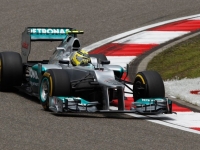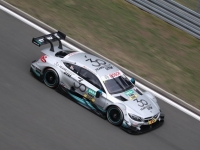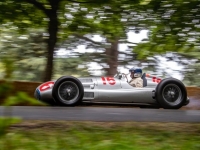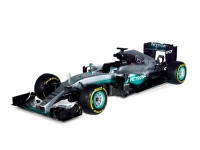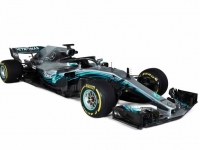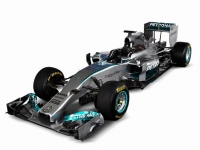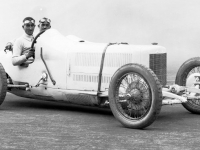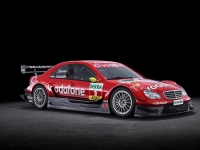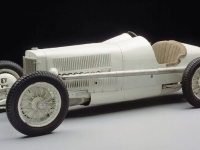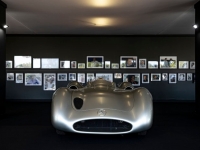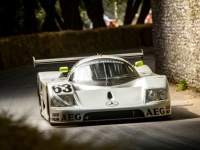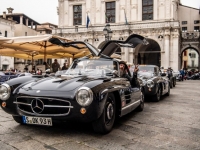Automobiles
Historic racing cars in Hockenheim
125 Years of Motorsports
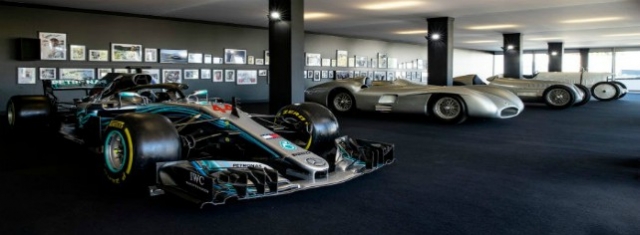
Mercedes-Benz presentation of 125 Years of Motors (Source: © 2019 Daimler AG. All rights reserved.)
USPA NEWS -
Mercedes-Benz Classic at the Formula 1 Grosser Preis von Deutschland in 2019: Historic racing cars in Hockenheim for the anniversary “125 Years of Motorsports“
On 28 July 2019 Mercedes-Benz Classic celebrates “ 125 Years of Motorsports“ at the Formula 1 Mercedes-Benz Grosser Preis von Deutschland at the Hockenheimring. Besides extensive event activities, numerous vehicles from the company´s own collection commemorate the highlights of motorsports history since 1894.
On 28 July 2019 Mercedes-Benz Classic celebrates “ 125 Years of Motorsports“ at the Formula 1 Mercedes-Benz Grosser Preis von Deutschland at the Hockenheimring. Besides extensive event activities, numerous vehicles from the company´s own collection commemorate the highlights of motorsports history since 1894.
The best drivers fighting for victory: this is how it is at the Formula 1 Mercedes-Benz Grosser Preis von Deutschland at the Hockenheimring ““ with Mercedes-Benz as the main sponsor. And this is how it has been for 125 years. That is when the story of competitive motorcar racing came into being ““ in 1894, when the first competitive car race in history took place in France, from Paris to Rouen. The first prize was shared by two vehicles with Daimler engines, and a Benz & Cie. vehicle was awarded fifth prize. Mercedes-Benz is celebrating its anniversary up to and beyond 2019 at numerous events.
History of looking forward
In Hockenheim, just 80 kilometres from Stuttgart as the crow flies, the brand underlines its spirit with an impressive presentation of historic racing cars. With every race Mercedes-Benz extends the spirit of motorsport into the future ““ with a will to compete and win going back 125 years.
Today´s story unfolds with Mercedes AMG Petronas F1 Motorsport. For a start, the 2019 Formula One racing cars are sporting a special livery at the Hockenheimring in honour of the “125 Years of Motorsport“ anniversary. The livery pays tribute to the racing heriage of the brand and features the classic design Mercedes star. Additioanlly, the whole team will be wearing the new overalls resembling the overalls of the racing teams of the 1930´s and 1950´s
In Hockenheim, just 80 kilometres from Stuttgart as the crow flies, the brand underlines its spirit with an impressive presentation of historic racing cars. With every race Mercedes-Benz extends the spirit of motorsport into the future ““ with a will to compete and win going back 125 years.
Today´s story unfolds with Mercedes AMG Petronas F1 Motorsport. For a start, the 2019 Formula One racing cars are sporting a special livery at the Hockenheimring in honour of the “125 Years of Motorsport“ anniversary. The livery pays tribute to the racing heriage of the brand and features the classic design Mercedes star. Additioanlly, the whole team will be wearing the new overalls resembling the overalls of the racing teams of the 1930´s and 1950´s
Mercedes-Benz´s motorsports history has countless facets and many exciting stories to tell. In addition to the cars, this also includes the professional management of racing activities. One of the legendary race directors of the brand is Alfred Neubauer. In the 1930s and 1950s, he choreographed the events on outstanding racing circuits all around the world. With an unprecedented insistence on perfection, he set new standards in preparation and execution and introduced new methods time and again.
One of Neubauer´s inventions was the communication between the pits and driver using flags and number signs. In the time before car-to-pit radios, this is how the drivers were kept informed about what was happening in front of and behind them during the race. One of the exhibits on display in Hockenheim is one of Neubauer´s original racing boxes with the corresponding utensils.
One of Neubauer´s inventions was the communication between the pits and driver using flags and number signs. In the time before car-to-pit radios, this is how the drivers were kept informed about what was happening in front of and behind them during the race. One of the exhibits on display in Hockenheim is one of Neubauer´s original racing boxes with the corresponding utensils.
Motorsport gems
The Mercedes-Benz Classic vehicle exhibition at the Hockenheimring will be particularly impressive. The gems brought along from the company´s own collection include the two-cylinder Daimler-Motoren-Gesellschaft engine, which was the initiator of the company´s racing tradition in 1894.
This motorsports starting point transports us directly to events 125 years later and Formula One at the Hockenheimring: on the circuit we have the Mercedes-AMG F1 W10 EQ Power+. So fart the car has won nine out of the ten races in the 2019 season and has already established a firm place in the Mercedes-Benz motorsports chronicle. No less impressive are the Formula One cars of the 2012 (World Champion Nico Rosberg), 2014 (World Champion Lewis Hamilton), 2016 (World Champion Nico Rosberg), and 2018 (World Champion Lewis Hamilton) seasons, which the company will be showing to fans at Hockenheim.
The Mercedes-Benz Classic vehicle exhibition at the Hockenheimring will be particularly impressive. The gems brought along from the company´s own collection include the two-cylinder Daimler-Motoren-Gesellschaft engine, which was the initiator of the company´s racing tradition in 1894.
This motorsports starting point transports us directly to events 125 years later and Formula One at the Hockenheimring: on the circuit we have the Mercedes-AMG F1 W10 EQ Power+. So fart the car has won nine out of the ten races in the 2019 season and has already established a firm place in the Mercedes-Benz motorsports chronicle. No less impressive are the Formula One cars of the 2012 (World Champion Nico Rosberg), 2014 (World Champion Lewis Hamilton), 2016 (World Champion Nico Rosberg), and 2018 (World Champion Lewis Hamilton) seasons, which the company will be showing to fans at Hockenheim.
Racing cars from Formula One and other racing series
Standing alongside other famous racing car legends from the brand´s racing history are many other cars. In 1924, for example, the Mercedes 2-litre eight-cylinder racing car competed ““ it will be on display at the German Grand Prix together with several Silver Arrows from the first era from 1934 to 1939: the W 125 from 1937 as well as the W 154 from the 3-litre period and a 1.5-litre W 165 racing car, which was constructed for only one Grand Prix. At the Tripolis Grand Prix on 7 May 1939, the first and only for the W 165, Lang and Caracciola gain an impressive double victory. The fastest competitor finished the race over four minutes later.
Standing alongside other famous racing car legends from the brand´s racing history are many other cars. In 1924, for example, the Mercedes 2-litre eight-cylinder racing car competed ““ it will be on display at the German Grand Prix together with several Silver Arrows from the first era from 1934 to 1939: the W 125 from 1937 as well as the W 154 from the 3-litre period and a 1.5-litre W 165 racing car, which was constructed for only one Grand Prix. At the Tripolis Grand Prix on 7 May 1939, the first and only for the W 165, Lang and Caracciola gain an impressive double victory. The fastest competitor finished the race over four minutes later.
The W 196 R with its streamlined body stands for the company´s extremely successful re-entry into motorsport after the Second World War. Together with the open-wheel version, it was used in Formula One in 1954 and 1955, giving Juan Manuel Fangio the World Championship in both years.
The 1000 Miglia endurance race in Italy is also a fixture in the racing calendar. At the 1955 Mille Miglia, John Cooper Fitch and co-driver Kurt Gessl finished first in their class and fifth in the overall classification in a 300 SL Gullwing with number 417, and this is commemorated by the coupé on show at Hockenheim bearing exactly the same number.
The 1000 Miglia endurance race in Italy is also a fixture in the racing calendar. At the 1955 Mille Miglia, John Cooper Fitch and co-driver Kurt Gessl finished first in their class and fifth in the overall classification in a 300 SL Gullwing with number 417, and this is commemorated by the coupé on show at Hockenheim bearing exactly the same number.
Victory at Le Mans and success in touring cars
At another classic endurance competition, cars sporting the star won a double victory in 1989, exactly 30 years ago: Sauber-Mercedes C 9 won the 24 Hours of Le Mans. One of the brand´s Group C racing cars will be on display on the occasion of the German Grand Prix 2019. Three original DTM racing cars from the 1994, 2006 and 2018 seasons stand for the numerous further successes in touring car racing.
In this way, the fascinating and unique racing history that has always been fired on by a will to compete and win comes full circle: from the birth of motorsport 125 years ago to the triple DTM Championship for Mercedes-AMG in 2018 and the overwhelming season opener in Formula One in 2019 with eight consecutive race victories for the modern Silver Arrows.
At another classic endurance competition, cars sporting the star won a double victory in 1989, exactly 30 years ago: Sauber-Mercedes C 9 won the 24 Hours of Le Mans. One of the brand´s Group C racing cars will be on display on the occasion of the German Grand Prix 2019. Three original DTM racing cars from the 1994, 2006 and 2018 seasons stand for the numerous further successes in touring car racing.
In this way, the fascinating and unique racing history that has always been fired on by a will to compete and win comes full circle: from the birth of motorsport 125 years ago to the triple DTM Championship for Mercedes-AMG in 2018 and the overwhelming season opener in Formula One in 2019 with eight consecutive race victories for the modern Silver Arrows.
The Mercedes-Benz Classic cars and exhibits at the 2019 German Grand Prix
Daimler two-cylinder V-engine (1894)
The V-twin engine Gottlieb Daimler and Wilhelm Maybach developed in 1888 formed the drivetrain of the “Daimler Motor-Quadricycle“, also known as the “Stahlradwagen“ (steel-wheeled car), a vehicle showcased at the Paris Exhibition in 1889. In 1894, this engine also formed the basis for the origins of motorsports: at the Paris-Rouen race, the world´s first motorcar competition in July 1894, vehicles by Peugeot and Panhard & Levassor won first prize ““ and they repeated their success in June 1895 at the first “real“ race from Paris to Bordeaux and back to Paris, which included speed ratings. The winning cars featured the V-twin engine designed by Daimler and Maybach, which was manufactured by Panhard & Levassor under licence. The engine installed in the Daimler “ steel-wheeled car“ originally had an output of 1.1 kW (1.5 bhp) and an engine size of 565 cc. Later variants, such as those used in the first races, delivered up to 2.75 kW (3.75 bhp) from engines up to 1,646 cc.
Daimler two-cylinder V-engine (1894)
The V-twin engine Gottlieb Daimler and Wilhelm Maybach developed in 1888 formed the drivetrain of the “Daimler Motor-Quadricycle“, also known as the “Stahlradwagen“ (steel-wheeled car), a vehicle showcased at the Paris Exhibition in 1889. In 1894, this engine also formed the basis for the origins of motorsports: at the Paris-Rouen race, the world´s first motorcar competition in July 1894, vehicles by Peugeot and Panhard & Levassor won first prize ““ and they repeated their success in June 1895 at the first “real“ race from Paris to Bordeaux and back to Paris, which included speed ratings. The winning cars featured the V-twin engine designed by Daimler and Maybach, which was manufactured by Panhard & Levassor under licence. The engine installed in the Daimler “ steel-wheeled car“ originally had an output of 1.1 kW (1.5 bhp) and an engine size of 565 cc. Later variants, such as those used in the first races, delivered up to 2.75 kW (3.75 bhp) from engines up to 1,646 cc.
Technical specifications of the Daimler two-cylinder V-engine
Period of use: 1889 to 1896
Cylinders: 2/arranged in V
Displacement: Up to 1,646 cc
Output: Up to 2.75 kW (3.75 bhp)
Period of use: 1889 to 1896
Cylinders: 2/arranged in V
Displacement: Up to 1,646 cc
Output: Up to 2.75 kW (3.75 bhp)
Mercedes 2-litre eight-cylinder Monza racing car (1924)
In 1924, Daimler-Motoren-Gesellschaft (DMG) introduced a new racing car based on the 2-litre formula regulations. This was one of Ferdinand Porsche´s first independent designs after joining DMG in 1923 as chief designer. The racing car was given the nickname “ Monza“ due to the location at which it celebrated its premiere. The innovative concept included an eight-cylinder engine ““ the first one developed by Daimler-Motoren-Gesellschaft for road vehicles. Today it would be called a high rpm concept: 7,000 rpm in those days was considered exorbitant, as was the power of 125 kW (170 bhp) generated by the 2-litre engine for a vehicle that weighed only 780 kilograms. The end was, however, a tragic one: in the Monza race in October 1924, the car proved to be very difficult to control and problematic, and Count Louis Vorow Zborowski lost his life in an accident. The racing car was nevertheless developed further and achieved several successes. The greatest was Rudolf Caracciola´s victory at the German Grand Prix on the Avus racetrack in Berlin on 11 July 1926 ““ his first international success.
In 1924, Daimler-Motoren-Gesellschaft (DMG) introduced a new racing car based on the 2-litre formula regulations. This was one of Ferdinand Porsche´s first independent designs after joining DMG in 1923 as chief designer. The racing car was given the nickname “ Monza“ due to the location at which it celebrated its premiere. The innovative concept included an eight-cylinder engine ““ the first one developed by Daimler-Motoren-Gesellschaft for road vehicles. Today it would be called a high rpm concept: 7,000 rpm in those days was considered exorbitant, as was the power of 125 kW (170 bhp) generated by the 2-litre engine for a vehicle that weighed only 780 kilograms. The end was, however, a tragic one: in the Monza race in October 1924, the car proved to be very difficult to control and problematic, and Count Louis Vorow Zborowski lost his life in an accident. The racing car was nevertheless developed further and achieved several successes. The greatest was Rudolf Caracciola´s victory at the German Grand Prix on the Avus racetrack in Berlin on 11 July 1926 ““ his first international success.
Technical data of the Mercedes 2-litre eight-cylinder Monza racing car
Period of use: 1924 to 1927
Cylinders: 8/in-line
Displacement: 1,996 cc
Output: Up to 125 kW (170 bhp)
Top speed: 180 km/h
Period of use: 1924 to 1927
Cylinders: 8/in-line
Displacement: 1,996 cc
Output: Up to 125 kW (170 bhp)
Top speed: 180 km/h
Mercedes-Benz 750-kilogram W 125 racing car (1937)
When it became clear in the 1936 season that, despite two Grand Prix victories, the W 25 was no longer competitive, a dedicated Technical Director was appointed to the racing department ““ engineer Rudolf Uhlenhaut. He was also a talented and very fast driver. Having thoroughly tested the W 25 under racing conditions, Uhlenhaut chose a revolutionary chassis design with a rigid frame, soft suspension and strong damping for the successor, the W 125. The eight-cylinder, in-line engine was also meticulously improved and, after having been equipped with a supercharger and increasing its engine capacity to 5.7 litres, the unit developed an output of up to 435 kW (592 bhp). It took until the 1980s before the same level of engine output was once again generated by a Grand Prix racing car. With Hermann Lang at the wheel, the new Silver Arrow was triumphant in its very first race, the Tripoli Grand Prix (Libya) and went on to dominate the rest of the 1937 racing season. At the end of the season Rudolf Caracciola won his second European Grand Prix Championship.
When it became clear in the 1936 season that, despite two Grand Prix victories, the W 25 was no longer competitive, a dedicated Technical Director was appointed to the racing department ““ engineer Rudolf Uhlenhaut. He was also a talented and very fast driver. Having thoroughly tested the W 25 under racing conditions, Uhlenhaut chose a revolutionary chassis design with a rigid frame, soft suspension and strong damping for the successor, the W 125. The eight-cylinder, in-line engine was also meticulously improved and, after having been equipped with a supercharger and increasing its engine capacity to 5.7 litres, the unit developed an output of up to 435 kW (592 bhp). It took until the 1980s before the same level of engine output was once again generated by a Grand Prix racing car. With Hermann Lang at the wheel, the new Silver Arrow was triumphant in its very first race, the Tripoli Grand Prix (Libya) and went on to dominate the rest of the 1937 racing season. At the end of the season Rudolf Caracciola won his second European Grand Prix Championship.
Technical data of Mercedes-Benz 750-kilogram W 125 racing car
Period of use: 1937
Cylinders: 8/in-line
Displacement: 5,663 cc
Output: Up to 435 kW (592 bhp)
Top speed: 320 km/h
Period of use: 1937
Cylinders: 8/in-line
Displacement: 5,663 cc
Output: Up to 435 kW (592 bhp)
Top speed: 320 km/h
Mercedes-Benz 3-litre formula W 154 racing car (1939)
The W 154 was Mercedes-Benz´s answer to the new regulations which were introduced for the 1938 Grand Prix European Championship season. As the decisive technical factor, the displacement was now limited: a maximum of 3 litres with a compressor or 4.5 litres without. In restricting the engine capacity, the international motorsport association was aiming to lower engine output and, consequently, the speed of the racing cars. Mercedes-Benz again relied on tried-and-tested supercharging and developed a V12 engine that achieved 333 kW (453 bhp) at 8,000 rpm. In spite of the fact that the displacement had now been virtually halved, the W 154 lost practically no speed compared to its predecessor. In 1938 it won six of the nine most important races ““ including three one-two-three victories as well as one one-two finish ““ and helped Rudolf Caracciola win his third European Championship title. In 1939 the thoroughly revised and performance-enhanced W 154 won five times in seven races ““ this time the most successful driver was Hermann Lang, earning four of the five wins.
The W 154 was Mercedes-Benz´s answer to the new regulations which were introduced for the 1938 Grand Prix European Championship season. As the decisive technical factor, the displacement was now limited: a maximum of 3 litres with a compressor or 4.5 litres without. In restricting the engine capacity, the international motorsport association was aiming to lower engine output and, consequently, the speed of the racing cars. Mercedes-Benz again relied on tried-and-tested supercharging and developed a V12 engine that achieved 333 kW (453 bhp) at 8,000 rpm. In spite of the fact that the displacement had now been virtually halved, the W 154 lost practically no speed compared to its predecessor. In 1938 it won six of the nine most important races ““ including three one-two-three victories as well as one one-two finish ““ and helped Rudolf Caracciola win his third European Championship title. In 1939 the thoroughly revised and performance-enhanced W 154 won five times in seven races ““ this time the most successful driver was Hermann Lang, earning four of the five wins.
Technical data of the Mercedes-Benz W 154 3-litre formula racing car
Period of use: 1938 to 1939 and 1951
Cylinders: V12
Displacement: 2,963 cc
Output: 344 kW (468 bhp) to 355 kW (483 bhp)
Top speed: Around 300 km/h
Period of use: 1938 to 1939 and 1951
Cylinders: V12
Displacement: 2,963 cc
Output: 344 kW (468 bhp) to 355 kW (483 bhp)
Top speed: Around 300 km/h
Mercedes-Benz 1.5-litre W 165 racing car (1939)
Mercedes-Benz developed the W 165 for one single race ““o o o o o the 1939 Tripoli Grand Prix in Libya. Italian event organisers exclusively advertised this race for voiturette formula vehicles with a 1.5-litre engine. This was aimed at bringing to an end the series of victories by German competitors as neither Mercedes-Benz (Tripoli winner in 1935, 1937 and 1938) nor Auto Union (winner in 1936) provided a racing car for this category. However, the racing department in Stuttgart accepted the challenge and built an all-new 1.5-litre formula within less than eight months. Two W 165s took up the gauntlet on 7 May 1939 despite being vastly outnumbered by the competition consisting of 28 red Alfa Romeos and Maseratis. They went on to secure a triumphant one-two win: Hermann Lang won the spectacular desert race for the third time, Rudolf Caracciola finished second. The fastest Italian car crossed the finishing line a good 4 minutes after the Silver Arrows.
Technical data of the Mercedes-Benz 1.5-litre W 165 racing car
Period of use: 1939
Cylinders: V8
Displacement: 1,493 cc
Max. output: 187 kW (254 bhp)
Top speed: 272 km/h
Mercedes-Benz developed the W 165 for one single race ““o o o o o the 1939 Tripoli Grand Prix in Libya. Italian event organisers exclusively advertised this race for voiturette formula vehicles with a 1.5-litre engine. This was aimed at bringing to an end the series of victories by German competitors as neither Mercedes-Benz (Tripoli winner in 1935, 1937 and 1938) nor Auto Union (winner in 1936) provided a racing car for this category. However, the racing department in Stuttgart accepted the challenge and built an all-new 1.5-litre formula within less than eight months. Two W 165s took up the gauntlet on 7 May 1939 despite being vastly outnumbered by the competition consisting of 28 red Alfa Romeos and Maseratis. They went on to secure a triumphant one-two win: Hermann Lang won the spectacular desert race for the third time, Rudolf Caracciola finished second. The fastest Italian car crossed the finishing line a good 4 minutes after the Silver Arrows.
Technical data of the Mercedes-Benz 1.5-litre W 165 racing car
Period of use: 1939
Cylinders: V8
Displacement: 1,493 cc
Max. output: 187 kW (254 bhp)
Top speed: 272 km/h
Mercedes-Benz Formula One W 196 R racing car (1955)
The W 196 R marked Mercedes-Benz´s return to Grand Prix racing in 1954 following a 15-year break. The new Silver Arrow´s design complied with a new rule that had just come into force, stipulating a maximum engine size of 2.5 litres. In the car´s very first race on 4 July 1954 in Rheims, Juan Manuel Fangio and Karl Kling posted a spectacular one-two finish. Designed for fast race tracks, the futuristic looking vehicle featured a streamlined body ““ the same as the body on show. Following three more victories, Fangio finished the season as Formula One World Champion. However, in most of the Formula One races in 1954 and 1955, it was not the streamlined version, but rather the version with open wheels that was used. This version was more suitable for winding tracks, as the driver always had the front wheels in view. Fangio won the Italian Grand Prix in Monza in September 1955 with the more powerful version of the streamlined vehicle to claim the World Championship once again at the wheel of a Mercedes-Benz.
The W 196 R marked Mercedes-Benz´s return to Grand Prix racing in 1954 following a 15-year break. The new Silver Arrow´s design complied with a new rule that had just come into force, stipulating a maximum engine size of 2.5 litres. In the car´s very first race on 4 July 1954 in Rheims, Juan Manuel Fangio and Karl Kling posted a spectacular one-two finish. Designed for fast race tracks, the futuristic looking vehicle featured a streamlined body ““ the same as the body on show. Following three more victories, Fangio finished the season as Formula One World Champion. However, in most of the Formula One races in 1954 and 1955, it was not the streamlined version, but rather the version with open wheels that was used. This version was more suitable for winding tracks, as the driver always had the front wheels in view. Fangio won the Italian Grand Prix in Monza in September 1955 with the more powerful version of the streamlined vehicle to claim the World Championship once again at the wheel of a Mercedes-Benz.
Technical data of the Mercedes-Benz Formula One W 196 R racing car
Period of use: 1954 to 1955
Cylinders: 8/in-line
Displacement: 2,497 cc
Output: 188 kW (256 bhp) to 213 kW (290 bhp)
Top speed: Up to 300 km/h
Period of use: 1954 to 1955
Cylinders: 8/in-line
Displacement: 2,497 cc
Output: 188 kW (256 bhp) to 213 kW (290 bhp)
Top speed: Up to 300 km/h
Mercedes-Benz 300 SL Gullwing (W 198, 1955)
Unveiled in 1954, the 300 SL series production sports car (W 198) was based on the eponymous racing car (W 194), which had posted some spectacular successes in the 1952 season. The innovative petrol injection allowed a 20 per cent increase in output compared to the carburettor racing version. With a top speed of up to 250 km/h, the 300 SL was the fastest series production vehicle of its era, which also meant it was predestined to be used in motorsports. At the 1955 Mille Miglia, John Cooper Fitch and co-driver Kurt Gessl finished fifth in the overall classification in a 300 SL with start number 417. In the same year, Werner Engel won the European Touring Car Championship at the wheel of the 300 SL while Paul O´Shea was victorious in category D of the US sports car championship, which he went on to win again in 1956. A total of 1,400 units of the dream sports car were produced between 1954 and 1957. In 1999, the 300 SL Gullwing was voted sports car of the century by a panel of journalists.
Unveiled in 1954, the 300 SL series production sports car (W 198) was based on the eponymous racing car (W 194), which had posted some spectacular successes in the 1952 season. The innovative petrol injection allowed a 20 per cent increase in output compared to the carburettor racing version. With a top speed of up to 250 km/h, the 300 SL was the fastest series production vehicle of its era, which also meant it was predestined to be used in motorsports. At the 1955 Mille Miglia, John Cooper Fitch and co-driver Kurt Gessl finished fifth in the overall classification in a 300 SL with start number 417. In the same year, Werner Engel won the European Touring Car Championship at the wheel of the 300 SL while Paul O´Shea was victorious in category D of the US sports car championship, which he went on to win again in 1956. A total of 1,400 units of the dream sports car were produced between 1954 and 1957. In 1999, the 300 SL Gullwing was voted sports car of the century by a panel of journalists.
Technical data of the Mercedes-Benz 300 SL “ Gullwing“ (W 198)
Period of use: 1955 to 1957
Cylinders: 6/in-line
Displacement: 2,996 cc
Power: 158 kW (215 bhp)
Top speed: Up to 250 km/h
Period of use: 1955 to 1957
Cylinders: 6/in-line
Displacement: 2,996 cc
Power: 158 kW (215 bhp)
Top speed: Up to 250 km/h
Sauber-Mercedes C 9 Group C racing sports car (1989)
The late 1980s were marked by Mercedes-Benz´s return to the race track: Group C racing cars were the first to bear the star. Sauber-Mercedes C 9 vehicles had been featuring black or dark blue livery since 1987, but in 1989 they were also updated visually: from now on they were painted in silver to identify them clearly as Mercedes-Benz Silver Arrows. In 1989 alone, the new racing cars came out top in eight of their nine races. One of those was the 24 Hours of Le Mans on 10 and 11 June 1989: Mercedes-Benz drivers Jochen Mass / Manuel Reuter / Stanley Dickens and Mauro Baldi / Kenny Acheson / Gianfranco Brancatelli raced to a one-two finish in the two C 9 Silver Arrows ““ 37 years after the outstanding success with the first Silver Arrows, the Mercedes-Benz 300 SL racing car (W 194), achieved after the Second World War. At the end of the season, Jean-Louis Schlesser won the World Sportscar Championship in the C 9.
Technical specifications of the Sauber-Mercedes C 9 Group C racing sports car
Period of use: 1989 to 1990
Cylinders: V8
Displacement: 4,973 cc
Output: 530 kW (720 bhp)
Top speed: 400 km/h
The late 1980s were marked by Mercedes-Benz´s return to the race track: Group C racing cars were the first to bear the star. Sauber-Mercedes C 9 vehicles had been featuring black or dark blue livery since 1987, but in 1989 they were also updated visually: from now on they were painted in silver to identify them clearly as Mercedes-Benz Silver Arrows. In 1989 alone, the new racing cars came out top in eight of their nine races. One of those was the 24 Hours of Le Mans on 10 and 11 June 1989: Mercedes-Benz drivers Jochen Mass / Manuel Reuter / Stanley Dickens and Mauro Baldi / Kenny Acheson / Gianfranco Brancatelli raced to a one-two finish in the two C 9 Silver Arrows ““ 37 years after the outstanding success with the first Silver Arrows, the Mercedes-Benz 300 SL racing car (W 194), achieved after the Second World War. At the end of the season, Jean-Louis Schlesser won the World Sportscar Championship in the C 9.
Technical specifications of the Sauber-Mercedes C 9 Group C racing sports car
Period of use: 1989 to 1990
Cylinders: V8
Displacement: 4,973 cc
Output: 530 kW (720 bhp)
Top speed: 400 km/h
AMG-Mercedes C-Class racing touring car (W 202), 1994
In 1994 Mercedes-Benz competed in the DTM with a new racing touring car based on the W 202 C-Class Saloon. The reinforced monocoque bodywork with a welded rollover cage concealed thoroughbred racing technology: as required by the race rules, the new high-performance engine was based on a production engine. The engineers at AMG designed a V6 engine developed from the 4.2-litre M 119 V8 engine, which conformed to the prescribed displacement limit with 2,500 cubic centimetres. Capable of up to 11,000 rpm, the engine transferred its power via a sequential transmission. For weight reasons the bonnet, boot lid and mounted aerodynamic parts were of carbon fibre/Kevlar. In 1994 Klaus Ludwig became German Touring Car Champion with this car. In the following year Mercedes-Benz entered the DTM and ITC with a further development of the racing touring car ““ Bernd Schneider won both race series and Mercedes-Benz secured the brand championship.
Technical data of the AMG Mercedes C-Class racing touring car
Period of use: 1994 to 1996
Cylinders: V6
Displacement: 2,499 cc
Output: 324 kW (440 bhp)
Top speed: 300 km/h
In 1994 Mercedes-Benz competed in the DTM with a new racing touring car based on the W 202 C-Class Saloon. The reinforced monocoque bodywork with a welded rollover cage concealed thoroughbred racing technology: as required by the race rules, the new high-performance engine was based on a production engine. The engineers at AMG designed a V6 engine developed from the 4.2-litre M 119 V8 engine, which conformed to the prescribed displacement limit with 2,500 cubic centimetres. Capable of up to 11,000 rpm, the engine transferred its power via a sequential transmission. For weight reasons the bonnet, boot lid and mounted aerodynamic parts were of carbon fibre/Kevlar. In 1994 Klaus Ludwig became German Touring Car Champion with this car. In the following year Mercedes-Benz entered the DTM and ITC with a further development of the racing touring car ““ Bernd Schneider won both race series and Mercedes-Benz secured the brand championship.
Technical data of the AMG Mercedes C-Class racing touring car
Period of use: 1994 to 1996
Cylinders: V6
Displacement: 2,499 cc
Output: 324 kW (440 bhp)
Top speed: 300 km/h
AMG Mercedes C-Class DTM touring car (W 203, 2006)
Initially vehicles closely relating to the standard version on the basis of two-door coupés were used in the new DTM, launched in the 2000 season as the “German Touring Car Masters“, and from 2004 four-door saloons were then used. The C-Class touring car on the basis of model series 203 featured a supporting tubular frame with a steel roof and side walls into which the safety cell for the driver was fitted. The external claddings and detachable parts were of lightweight yet highly resistant carbon-fibre reinforced plastic. A V8 was used as the engine. The unit had already been doing a great job since 2000 in the DTM vehicle on the basis of the CLK. The C-Class racing touring car was further improved for the 2005 season, e.g. reducing the vehicle weight by 30 kilograms and increasing both the body length and wheelbase. In 2005, Gary Paffett secured the DTM drivers´ title. In the following year Bernd Schneider became German Touring Car Champion for the fifth time ““ and repeated this triumph in 2006 with the vehicle exhibited here.
Initially vehicles closely relating to the standard version on the basis of two-door coupés were used in the new DTM, launched in the 2000 season as the “German Touring Car Masters“, and from 2004 four-door saloons were then used. The C-Class touring car on the basis of model series 203 featured a supporting tubular frame with a steel roof and side walls into which the safety cell for the driver was fitted. The external claddings and detachable parts were of lightweight yet highly resistant carbon-fibre reinforced plastic. A V8 was used as the engine. The unit had already been doing a great job since 2000 in the DTM vehicle on the basis of the CLK. The C-Class racing touring car was further improved for the 2005 season, e.g. reducing the vehicle weight by 30 kilograms and increasing both the body length and wheelbase. In 2005, Gary Paffett secured the DTM drivers´ title. In the following year Bernd Schneider became German Touring Car Champion for the fifth time ““ and repeated this triumph in 2006 with the vehicle exhibited here.
Technical data of the AMG Mercedes C-Class racing touring car (W 203)
Period of use: 2004 to 2007
Cylinders: V8
Displacement: 4,000 cc
Output: 346 kW (470 bhp)
Top speed: 280 km/h
Period of use: 2004 to 2007
Cylinders: V8
Displacement: 4,000 cc
Output: 346 kW (470 bhp)
Top speed: 280 km/h
Mercedes F1 W03 Formula One racing car (2012)
The works team with its new name Mercedes AMG Petronas F1 presented the Mercedes F1 W03 as part of the second test weekend in Barcelona on 21 February 2012. The 2012 regulations led to significant changes to the vehicle. These included, in particular, the pronounced stepped design of the nose and new restrictions on the exhaust-driven (blown) diffusers, which had provided aerodynamic benefits in 2011. In the third race of the season, the Chinese Grand Prix, the team experienced a turning point: the weekend started well with a pole position for Nico Rosberg ““ the first ever since Mercedes-Benz had returned to Formula One with its own works team two years earlier. Rosberg won the race and, in so doing, won the first victory for the Silver Arrows since the Italian Grand Prix in Monza on 11 September 1955.
The works team with its new name Mercedes AMG Petronas F1 presented the Mercedes F1 W03 as part of the second test weekend in Barcelona on 21 February 2012. The 2012 regulations led to significant changes to the vehicle. These included, in particular, the pronounced stepped design of the nose and new restrictions on the exhaust-driven (blown) diffusers, which had provided aerodynamic benefits in 2011. In the third race of the season, the Chinese Grand Prix, the team experienced a turning point: the weekend started well with a pole position for Nico Rosberg ““ the first ever since Mercedes-Benz had returned to Formula One with its own works team two years earlier. Rosberg won the race and, in so doing, won the first victory for the Silver Arrows since the Italian Grand Prix in Monza on 11 September 1955.
This was the first podium finish for the record World Champion in one of the new Silver Arrows. At the end of the season, Schumacher announced his retirement from Formula One. The vehicle exhibited here, with chassis number 01, was used throughout the entire season as a research and development vehicle.
Key data for the Mercedes F1 W03 Formula One racing car
Period of use: 2012
Formula One Constructors´ Championship: 5th place
Formula One Drivers´ Championship: Nico Rosberg ““ 9th place
Formula One Drivers´ Championship: Michael Schumacher ““ 13th place
Victories: 1
Pole positions: 1
Podium finishes: 3
Key data for the Mercedes F1 W03 Formula One racing car
Period of use: 2012
Formula One Constructors´ Championship: 5th place
Formula One Drivers´ Championship: Nico Rosberg ““ 9th place
Formula One Drivers´ Championship: Michael Schumacher ““ 13th place
Victories: 1
Pole positions: 1
Podium finishes: 3
Mercedes F1 W05 Hybrid Formula One racing car (2014)
The 2014 Formula One season saw the birth of a revolutionary racing formula when the focus turned to hybrid power in the champions league of motorsports. In that milestone year for motorsports, the Silver Arrows of the Mercedes AMG Petronas Formula One team returned to centre stage. As the challenger, the all-new Mercedes F1 W05 Hybrid carried the team to victory in the Constructors´ World Championship. Lewis Hamilton secured his second Drivers´ World Championship title after a duel with his teammate Nico Rosberg, which had lasted the full season. Rosberg ended the season after a dramatic showdown in the final race of the year in Abu Dhabi as the runner-up World Champion. In this record year, the Mercedes F1 W05 Hybrid made a lasting impression on the motorsports history of Mercedes-Benz. The vehicle exhibited, chassis number 01, was used by Lewis Hamilton in the first half of the season from Melbourne to the Austrian Grand Prix. Of the eight races in which the W05/01 competed, Hamilton was in pole position four times and won four times in Malaysia, Bahrain, China and Barcelona.
The 2014 Formula One season saw the birth of a revolutionary racing formula when the focus turned to hybrid power in the champions league of motorsports. In that milestone year for motorsports, the Silver Arrows of the Mercedes AMG Petronas Formula One team returned to centre stage. As the challenger, the all-new Mercedes F1 W05 Hybrid carried the team to victory in the Constructors´ World Championship. Lewis Hamilton secured his second Drivers´ World Championship title after a duel with his teammate Nico Rosberg, which had lasted the full season. Rosberg ended the season after a dramatic showdown in the final race of the year in Abu Dhabi as the runner-up World Champion. In this record year, the Mercedes F1 W05 Hybrid made a lasting impression on the motorsports history of Mercedes-Benz. The vehicle exhibited, chassis number 01, was used by Lewis Hamilton in the first half of the season from Melbourne to the Austrian Grand Prix. Of the eight races in which the W05/01 competed, Hamilton was in pole position four times and won four times in Malaysia, Bahrain, China and Barcelona.
Key data for the Mercedes F1 W05 Formula One racing car
Period of use: 2014
Formula One Constructors´ Championship: World Champion
Formula One Drivers´ Championship: Lewis Hamilton ““ World Champion
Formula One Drivers´ Championship: Nico Rosberg ““ Vice World Champion
Victories: 16
Double victories: 11
Pole positions: 18
Podium finishes: 31
Period of use: 2014
Formula One Constructors´ Championship: World Champion
Formula One Drivers´ Championship: Lewis Hamilton ““ World Champion
Formula One Drivers´ Championship: Nico Rosberg ““ Vice World Champion
Victories: 16
Double victories: 11
Pole positions: 18
Podium finishes: 31
Mercedes F1 W07 Hybrid Formula One racing car (2016)
The Mercedes F1 W07 Hybrid followed in the footsteps of two extremely successful predecessors in 2016 ““ the two Silver Arrows that went on to win the Formula One Drivers´ and Constructors´ World Championship in 2014 and 2015. This outstanding result was even repeated for the third time in a row. Both the Drivers´ and Constructors´ World Championships 2016 again went to the Mercedes-AMG Petronas Formula One team with Nico Rosberg as World Champion and his teammate Lewis Hamilton as Vice World Champion. Together, the two Silver Arrow drivers dominated the entire season from the start, as witnessed by the impressive record of 19 victories, 33 podium finishes, 20 pole positions, 121 section best times and 765 points. On the way to completing the triple, the F1 W07 Hybrid covered 8,073 laps ““ equivalent to a distance of more than 40,500 kilometres with over 133,000 bends and about 389,000 gear changes.
The Mercedes F1 W07 Hybrid followed in the footsteps of two extremely successful predecessors in 2016 ““ the two Silver Arrows that went on to win the Formula One Drivers´ and Constructors´ World Championship in 2014 and 2015. This outstanding result was even repeated for the third time in a row. Both the Drivers´ and Constructors´ World Championships 2016 again went to the Mercedes-AMG Petronas Formula One team with Nico Rosberg as World Champion and his teammate Lewis Hamilton as Vice World Champion. Together, the two Silver Arrow drivers dominated the entire season from the start, as witnessed by the impressive record of 19 victories, 33 podium finishes, 20 pole positions, 121 section best times and 765 points. On the way to completing the triple, the F1 W07 Hybrid covered 8,073 laps ““ equivalent to a distance of more than 40,500 kilometres with over 133,000 bends and about 389,000 gear changes.
The vehicle exhibited, chassis number 05, was used by Nico Rosberg from the Canada Grand Prix through to his winning the Drivers´ Championship in a thrilling final race of the season in Abu Dhabi. In 15 races, the car clinched five race victories, six pole positions and twelve podium positions. Overall, the 2016 record season for the Silver Arrows made the Mercedes F1 W07 Hybrid the most successful car in Formula One history.
Key data for the Mercedes F1 W07 Formula One racing car
Period of use: 2016
Formula One Constructors´ Championship: World Champion
Formula One Drivers´ Championship: Nico Rosberg ““ World Champion
Formula One Drivers´ Championship: Lewis Hamilton ““ Vice World Champion
Victories: 19 (world record)
Double victories: 8
Pole positions: 20 (world record)
Podium finishes: 33 (world record)
Key data for the Mercedes F1 W07 Formula One racing car
Period of use: 2016
Formula One Constructors´ Championship: World Champion
Formula One Drivers´ Championship: Nico Rosberg ““ World Champion
Formula One Drivers´ Championship: Lewis Hamilton ““ Vice World Champion
Victories: 19 (world record)
Double victories: 8
Pole positions: 20 (world record)
Podium finishes: 33 (world record)
Mercedes-AMG F1 W09 EQ Power+ Formula One racing car (2018)
The F1 W09 EQ Power+ was improved in all areas compared to its predecessor. The result was the fastest Formula One racing car to date sporting the three-pointed star. The W09 took the team to an impressive fifth consecutive double championship win ““ equalling Ferrari´s existing record. While in 2018 the team faced tougher competition from its strongest rivals, the W09 proved to be the front runner in the field at the end of the season. Lewis Hamilton picked up his fifth Drivers´ World Championship (Mexico Grand Prix)and is now one of only three Formula One drivers to have won the title five times or more ““ alongside Juan Manuel Fangio and Michael Schumacher. Mercedes-AMG Petronas Motorsport again secured the Constructors´ World Championship (Brazil Grand Prix). Lewis Hamilton and Valtteri Bottas together collected no fewer than 655 points. The Mercedes F1 W09 EQ Power+ completed a total of 7,791 laps in 2018, covering 38,854 kilometres including 128,631 bends and 381,586 gear changes.
The F1 W09 EQ Power+ was improved in all areas compared to its predecessor. The result was the fastest Formula One racing car to date sporting the three-pointed star. The W09 took the team to an impressive fifth consecutive double championship win ““ equalling Ferrari´s existing record. While in 2018 the team faced tougher competition from its strongest rivals, the W09 proved to be the front runner in the field at the end of the season. Lewis Hamilton picked up his fifth Drivers´ World Championship (Mexico Grand Prix)and is now one of only three Formula One drivers to have won the title five times or more ““ alongside Juan Manuel Fangio and Michael Schumacher. Mercedes-AMG Petronas Motorsport again secured the Constructors´ World Championship (Brazil Grand Prix). Lewis Hamilton and Valtteri Bottas together collected no fewer than 655 points. The Mercedes F1 W09 EQ Power+ completed a total of 7,791 laps in 2018, covering 38,854 kilometres including 128,631 bends and 381,586 gear changes.
Race data Mercedes-AMG F1 W09 EQ Power+ Formula One racing car
Period of use: 2018
Formula One Constructors´ Championship: World Champion
Formula One Drivers´ Championship: Lewis Hamilton ““ World Champion
Formula One Drivers´ Championship: Valtteri Bottas ““ 5th place
Wins: 11
Double wins: 4
Pole positions: 13
Podium finishes: 25
Period of use: 2018
Formula One Constructors´ Championship: World Champion
Formula One Drivers´ Championship: Lewis Hamilton ““ World Champion
Formula One Drivers´ Championship: Valtteri Bottas ““ 5th place
Wins: 11
Double wins: 4
Pole positions: 13
Podium finishes: 25
Mercedes-AMG C 63 DTM (C 205, 2018)
When the decision was taken at the end of 2015 to develop the 2017 Mercedes-AMG C 63 DTM, the engineers faced a number of complex challenges. New regulations specified numerous standardised parts on chassis, suspension and aerodynamics. Only a year later, new aerodynamic modifications and additional changes to the regulations had to be incorporated for the 2018 season. A reduction in permitted aerodynamic attachments meant the vehicle´s downforce was cut by around a third compared to the previous year. Component standardisation meant all the teams were more balanced, which promised exciting, close races. British driver Gary Paffett, 2005 DTM Champion, handled the new racing car and regulations best to secure his second DTM title at the end of a very exciting season. Mercedes-AMG Motorsport also claimed the team and brand title to bring 30 years of DTM commitment to an end with a spectacular triple victory.
Technical specifications of the Mercedes-AMG C 63 DTM (C 205)
Period of use: 2016 to 2018
Cylinders: V8
Displacement: 4,000 cc
Output: 360 kW (500 bhp)
Top speed: 280 km/h
When the decision was taken at the end of 2015 to develop the 2017 Mercedes-AMG C 63 DTM, the engineers faced a number of complex challenges. New regulations specified numerous standardised parts on chassis, suspension and aerodynamics. Only a year later, new aerodynamic modifications and additional changes to the regulations had to be incorporated for the 2018 season. A reduction in permitted aerodynamic attachments meant the vehicle´s downforce was cut by around a third compared to the previous year. Component standardisation meant all the teams were more balanced, which promised exciting, close races. British driver Gary Paffett, 2005 DTM Champion, handled the new racing car and regulations best to secure his second DTM title at the end of a very exciting season. Mercedes-AMG Motorsport also claimed the team and brand title to bring 30 years of DTM commitment to an end with a spectacular triple victory.
Technical specifications of the Mercedes-AMG C 63 DTM (C 205)
Period of use: 2016 to 2018
Cylinders: V8
Displacement: 4,000 cc
Output: 360 kW (500 bhp)
Top speed: 280 km/h
In the Mercedes-Benz museum:
Numerous exhibits in the Mercedes-Benz museum outline the motorsports history of Mercedes-Benz ““ especially in the room entitled Legend 7 “Silver Arrows ““ Races and Records“.
Numerous exhibits in the Mercedes-Benz museum outline the motorsports history of Mercedes-Benz ““ especially in the room entitled Legend 7 “Silver Arrows ““ Races and Records“.
more information: https://www.mercedes-benz.com/en/mercedes-benz/classic/museum/guided-tours-motorsport/
Liability for this article lies with the author, who also holds the copyright. Editorial content from USPA may be quoted on other websites as long as the quote comprises no more than 5% of the entire text, is marked as such and the source is named (via hyperlink).

